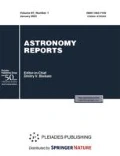Abstract
The evolution of large solar activity centers is studied, and the conditions resulting in powerful nonstationary processes are clarified. In addition to the factors that are usually considered (changes in sunspot area, the structure of magnetic fields, the character of motions), we examine to what extent observations of nonstationary processes (flares and associated coronal mass ejections) can be used to predict the development of such processes in the subsequent evolution of the activity center. We considered the example of a powerful group in October 2003, which could be observed before its appearance at the eastern limb using a spacecraft in near-Mars orbit. We plotted for events occurring in 2003 images of flares in various spectral ranges and analyzed high-energy processes in group 486, which was isolated at the beginning of its development, and then in the interrelated groups 486 and 484. The analysis of the peculiar early development of group 486 suggested that an intensification of the activity could be expected due to the emergence of new magnetic flux (and satellite groups), as well as the interaction and synchronization of two and then three large groups of the end of October 2003. In other words, in this case, extremely powerful nonstationary processes are associated with a relatively higher contribution of large-scale magnetic fields. We compare our results to analyses of motions and magnetic fields in this activity center throughout its transit across the disk from October 23 to November 5, 2003.
Similar content being viewed by others
References
M. Thomson, in The Dynamic Sun: Challenges for Theory and Observations, Proc. 11-th Europ. Solar Phys. Meeting, Ed. by D. Danesy, S. Poedts, A. De Groof, and J. Andries, ESASP-600,CD-ROM (2005).
V. M. Grigor’ev and L. V. Ermakova, Issl. Geomagn. Aeron. Fiz. Solntsa, No. 76, 25 (1986).
O. V. Chumak and Kh.-K. Tsang, Astron. Zh. 82, 847 (2005) [Astron. Rep. 49, 755 (2005)].
M. A. Livshits, V. A. Chernetskii, I. G. Mitrofanov, et al., Astron. Zh. 82, 1025 (2005) [Astron. Rep. 49, 916 (2005)].
M. A. Livshitz and O. G. Badalyan, Astron. Zh. 81,1138 (2004) [Astron. Rep. 48, 1037 (2004)].
D. S. Brown, R. W. Nightingale, D. Alexander, et al., Solar Phys. 216, 79 (2003).
V. N. Borovik, V. E. Abramov-Maksimov, I. Yu. Grigor’eva, et al., in Proc. of XI Pulkovo Intern. Conf. on Solar Physics Physical Priroda of Solar Activity and Prognozirovanie of Its Geophysical Proyavlenii, GAO RAN, Pulkovo, (GAO RAN, St. Petersburg, 2007), p. 67.
N. Gopalswamy, L. Barbieri, E. W. Cliver, et al., J. Geophys. Res. 110, A09S00, doi:10.1029/2005JA011268 (2005).
O. V. Chumak, Kh.-K. Tsang, and Zh. Guo, Astron. Zh. 85 (2008, in press).
I. M. Chertok and V. V. Grechnev, Astron. Zh. 82, 180 (2005) [Astron. Rep. 49, 155 (2005)].
I. M. Chertok and V. V. Grechnev, Solar Phys. 229, 95 (2005).
M. A. Livshitz, V. A. Chernetskii, A. V. Bogomolov, et al., Astron. Vestn. 40, 171 (2006) [Solar Syst. Res. 40, 153 (2006)].
R. P. Lin, B. R. Dennis, G. J. Harford, et al., Solar Phys. 210, 3 (2002).
D. M. Smith, R. P. Lin, P. Turin, et al., Solar Phys. 210, 61 (2002).
R. C. Puetter and R. K. Pina, Experim. Astron. 3, 293 (1994).
R. A. Schwartz, A. Csillaghy, A. K. Tolbert, et al., Solar Phys. 210, 165 (2002).
L. Maltagliati and A. Falchi, Solar Phys. 235, 125 (2006).
P. C. Grigis and A. O. Benz, Astron. and Astrophys. (2007, in press); e-Print arXiv:0708.2472v1 [astro-ph] (2007).
Author information
Authors and Affiliations
Additional information
Original Russian Text © L.K. Kashapova, M.A. Livshits, 2008, published in Astronomicheskiĭ Zhurnal, 2008, Vol. 85, No. 12, pp. 1129–1142.
Rights and permissions
About this article
Cite this article
Kashapova, L.K., Livshits, M.A. Eruptive processes at the beginning of development of powerful flare-active regions on the sun. Astron. Rep. 52, 1015–1026 (2008). https://doi.org/10.1134/S106377290812007X
Received:
Accepted:
Published:
Issue Date:
DOI: https://doi.org/10.1134/S106377290812007X




